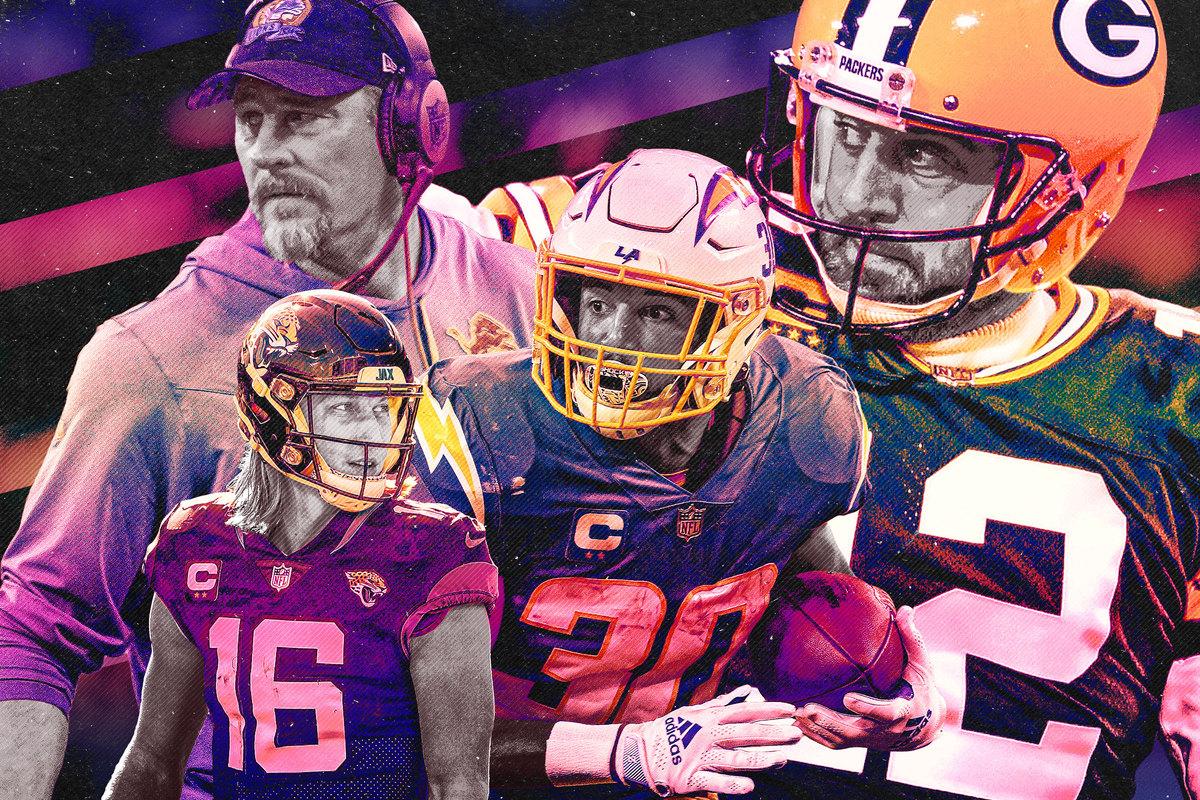The Five Teams NFL Contenders Should Be Afraid to See on Wild-Card Weekend
There’s always a team that sneaks into the first round of the playoffs and makes some noise. But in this bizarre season, there could be more than just one. Here are the teams that are getting healthy, figuring things out, or that just Have Tom Brady and could be dangerous in the postseason.
There’s always a Team You Don’t Want to See in the Playoffs. Every NFL season, some team gets hot in December and becomes the trendy pick to make a surprising run in January. It’s typically a no. 6 seed that strung together a few wins and bounced back from a disappointing start to the season—even though the real teams you don’t want to see in the playoffs are those that dominated all year. You know which team I wouldn’t want to see in the playoffs this season? The Chiefs. Or the 49ers, Bills, Eagles, or Bengals. You can even put the Cowboys on that list. Give me the easiest possible path to the Super Bowl. I am undeniably scared to compete.
Still, there’s been a late resurgence for many of the teams vying to play on wild-card weekend—so much so that it’s hard to figure out which might be the most dangerous to face. Just look at how drastically the standings have flipped from where they were a month ago.
Many of the teams making this late-season push entered the year with high expectations, so it’s impossible to dub just one the Team You Don’t Want to See. Instead, I picked five candidates that could send a playoff favorite home early—and ordered them based on my confidence in their ability to do so.
1. Packers: The Disappointing Team that’s Figured Things Out
As much as I would like to credit Aaron Rodgers finally ditching the Gary Oldman in The Fifth Element hairdo for sparking the Packers’ resurgence, their turnaround—which has Green Bay one win away from making the postseason—actually started before that. While the defense and special teams have done their parts—Green Bay is giving up 17 points a game over its past four and returner Keisean Nixon could make the All-Pro team after being stuck on the bench for half the season—the offense remains this team’s best unit. Since Week 10, that group ranks fifth in EPA and has scored 24 or more points in six of seven games. That streak includes Sunday’s 41-17 win over a 12-win Vikings team that held the Packers to seven points back in September.
Matt LaFleur and Rodgers have been tinkering with the offense throughout the season, and they found an approach that works back in a Week 10 win over the Cowboys. The Packers dialed back their usage of shotgun formations in that game and got into more under-center looks, and they’ve continued that trend over the ensuing seven weeks. After averaging just over 15 under-center snaps per game over the first half of the season, Green Bay has averaged 24 in the second half, according to TruMedia. That tweak has boosted the performance of the run game, as well as the efficacy of their play-action passes.
The Packers’ Under-Center Offense Has Improved
The aging Rodgers can still dial up some magical moments every now and then, and his numbers have improved during this hot streak, but a lot of the credit should go to LaFleur. The fourth-year coach has schemed around the loss of Davante Adams (at least, as much as that’s possible). The run game has grown more conceptually diverse with the Packers using more pull guards and calling more toss plays to get their backs on the perimeter. They’ve also started using rookie Christian Watson on jet sweeps to keep opposing linebackers honest. And all those moving parts have opened up the middle of the field when Rodgers keeps the ball after a play-action fake.
LaFleur has the offense humming, and Rodgers still has some high-level play left in him. If Joe Barry’s defense can replicate its performance against Minnesota, Green Bay might look more like the team we expected it to back in August—and would certainly be capable of giving any contender in the NFC a competitive game.
2. Chargers: The Team That’s Getting Healthy at the Right Time
Since their bye in Week 8, the Chargers own the NFL’s best pass defense by EPA. Compare that to the first eight weeks of the season, when they ranked 20th against the pass and 26th overall, according to RBSDM.com. Typically when you see a midseason improvement like that from a defense, it’s the result of an easier schedule that’s full of bad quarterbacks. That’s not the case for Los Angeles. Brandon Staley’s defense has held its own in games against the Chiefs, 49ers (with Jimmy Garoppolo), Dolphins, and, most recently, a Rams team that just dropped 51 points on a good Broncos defense. Making the turnaround more impressive, the Chargers did much of that damage with their two best defensive players sidelined by injuries. Derwin James has been in and out of the lineup throughout this stretch, and Joey Bosa returned Sunday after having been out since Week 3.
James suffered a concussion in Week 16, but he should be back in the lineup in time for the playoffs. Bosa’s snap count should be back to normal levels by then, too. And it’ll be interesting to see how Staley adapts now that his unit is back at full strength. He had been calling a more aggressive defensive system—using blitzes on early downs to defend the run more effectively and then heavily disguised coverages and pressures in obvious passing situations. But with Bosa back on the edge, L.A.’s four-man rushes should be far more effective. Having James out there may also convince Staley to be a bit more conservative. James is a ball hawk capable of making game-changing plays, so the Chargers don’t really have to chase turnovers as they did when they were shorthanded.
While getting healthier could allow the defense to play more conservatively, the imminent return of another star could have the opposite effect on the offense. Left tackle Rashawn Slater is working his way back from an early-season bicep tear that landed him on injured reserve. And though there still isn’t a clear timetable for his return, recent reports have suggested he’ll be good to go for the postseason. Jamaree Salyer has done a fine job of replacing Slater in the lineup, but he’s not a Pro Bowler; and if Salyer can kick over to right tackle—which is easier said than done—and fill that massive hole, Slater’s return could improve two positions at once. The Chargers passing game has been painfully limited in an effort to protect Justin Herbert behind a porous line. But with a more formidable pass protection unit, offensive coordinator Joe Lombardi might feel confident calling a few more deep shots and putting Herbert’s golden arm to good use.
There’s a reason this Chargers team was picked by many as a potential Super Bowl sleeper. There is a wealth of talent on the roster, and it’s finally starting to get healthy. Herbert has his weapons back and could have a full-strength offensive line soon enough. And Staley is proving that he just might be a defensive genius after all. A slow and injury-plagued start to the season will make the road to a Super Bowl tough to navigate, but this healthy version of the Chargers is capable of beating any team in the NFL.
3. Jaguars: The Team With the QB Who’s Made the Second-Year Leap
An elite quarterback can hide a lot of weaknesses. And while I’m not ready to start throwing around the E-word in regard to Trevor Lawrence, he’s been producing this season like the other guys who have earned the distinction.
It’s very possible that Lawrence has already taken that next step. He’s looked the part over the past few months, combining down-to-down consistency with a steady supply of “wow” plays that show off his generational skill set. He’s getting rid of the ball quicker, he’s avoiding the mental errors that cost Jacksonville games early on, and he’s elevated a mediocre cast of skill players.
Trevor Lawrence’s Ranks Since Week 9
Lawrence wasn’t at his best against Houston on Sunday, in a game the Jaguars treated like an exhibition affair, but even in his limited playing time, the 2021 first pick managed to put together a few highlight-reel throws.
A number of star quarterbacks have had second-year breakouts in recent seasons. We saw Joe Burrow help lead the Bengals to a Super Bowl last season. Patrick Mahomes came up one game short in 2018. And Lamar Jackson won a unanimous MVP for 2019. Because of the setback caused by Urban Meyer’s aggressive incompetence, and a general lack of trust in the Jaguars to do anything right, it can be difficult to view Lawrence’s season in a similar light. But all of the evidence (traditional stats, advanced metrics, tape, etc.) suggest it’s in that class. And if Lawrence and the Jaguars catch some AFC favorite on the wrong day, they won’t go away quietly.
4. Lions: The Team Built to Play in January (Supposedly)
There’s a persistent idea within the NFL that running the football effectively is conducive to winning in the playoffs. It makes some sense on paper: The weather is worse in January and February, and the refs get a bit more stingy with pass interference and defensive holding flags, so passing the ball isn’t nearly as easy as it is during the regular season. Some will argue those fancy-shmancy aerial attacks that work in 60-degree weather are no good when the games really start to matter. That in January, you win and lose in the trenches.
But if that were actually the case, the Lions would be a lot higher on this list. Unfortunately, it’s mostly nonsense. The teams really built for the playoffs are those capable of passing the football in any scenario, and we have more than a half-decade of evidence suggesting that Jared Goff is not a quarterback who can lead such a team. The features of playoff football (the cold weather and more forgiving refs) will certainly have an effect on Goff’s play if Detroit is able to end its playoff drought. But the bigger concern for Dan Campbell’s staff should be Goff’s play when the game script isn’t in his favor. When his average dropback probability (a metric based on score, down and distance, field position, and other situational factors) has been over 70 percent in a game, the Lions have gone 0-6, per the NFL FastR Play Index. When the Lions have kept Goff in a more favorable game script, and his average dropback probability remained under that 70-percent mark, they’ve gone 8-2.
Now, there is some selection bias there. A team that’s trailing late is going to find itself in more obvious passing situations, but 70 percent isn’t a terribly high number. The league’s average dropback probability rate for the season is 69 percent, suggesting that Goff needs ideal conditions to lead this team to a win.
A defense that struggles to stop the run and has to drop a safety into the box in order to do it might be vulnerable to the Lions offense. Coordinator Ben Johnson punishes teams that major in single-high coverages with play-action designs that attack the deeper parts of the field. But any team capable of putting Goff in obvious passing situations should handle Detroit with ease.
5. Buccaneers: The Team With Tom Fucking Brady
No team should fear the Buccaneers. The defense is old and creaky, the running game stinks, the offensive line can’t hold up long enough for Tom Brady to get through a full progression, and the coaching staff can’t get out of its own way. With all of that said, if you think I’m going to leave a team quarterbacked by Brady off this list, you’re out of your mind.
The offensive line has had a Dorian Gray effect on Brady at times this year—when he’s looked old, he’s looked old—but he’s also proved he’s still capable of turning in an elite performance when necessary. On Sunday against a Panthers team fighting for its season, Brady turned back the clock to 2020, throwing darts over the middle and perfectly weighted deep passes to the perimeter. Mike Evans caught three long touchdown passes, all on go routes, showing that Brady can still sling the ball like a man half his age.
Carolina did the Bucs a favor by playing a ton of zone coverage, but Brady picked it apart as he’s wont to do.
And if he comes across a defense that employs a similar approach—I’m looking at you, Philadelphia and Minnesota—the 45-year-old is capable of replicating the performance we saw in Tampa on Sunday.

